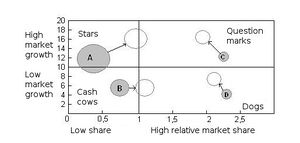Method of calculating the BCG matrix
| Method of calculating the BCG matrix |
|---|
| See also |
Using method of calculating the BCG matrix manager can produce graphical representation of the company position in the market relative to its major competitors. It was developed by Boston Counsulting Group in 1970. Growth share matrix is one of the best known and most widely used methods of portfolio analysis, which is a direct reflection of research participation and the competitiveness of companies in the market.
Construction of BCG Matrix chart and computational methods
Horizontal axis on a logarithmic scale indicates share of the company and its largest competitor. Vertical axis indicates rate of sales growth. The next step is the division of the horizontal axis into two parts at the point equals the share of its nearest competitor with a vertical axis at the point equal to half the span of market dynamics. This creates four quadrants of the chart, called the "star", "question marks" (or "difficult children"), "cash cows" and "dogs". These names are equivalent to the product development phases.
In the literature we can find the usual interpretation of the descriptive method of calculating the BCG matrix, but its application in practice requires some analytical procedures leading to the preparation of BCG graph.
Figure 1 shows a classic Boston consulting group matrix graph. Circles shows sales of particular brands on the market, with current sales mean grey circles, while the clear - the predicted sale.
The surfaces of the wheels represent the size of sales, their radius is calculated by the following formula:
Coordinates of the center of the wheel are calculated as follows:
- ,
- .
Procedure for creating the BCG matrix chart
- Identification of the firm's position in the market for each product, taking into account sales (own and competitor's) and rate of growth (in%)
- Based on these data to calculate the appropriate wheel radius and the x, y coordinates
- Drawing circles in the coordinate system and creating BCG map
- Analysis of the phases of development of different products.
References
- Calandro Jr, J., & Lane, S. (2007). A new competitive analysis tool: the relative profitability and growth matrix. Strategy & Leadership, 35(2), 30-38.
- Mutandwa, E., Kanuma, N. T., Rusatira, E., Kwiringirimana, T., Mugenzi, P., Govere, I., & Foti, R. (2009). Analysis of coffee export marketing in Rwanda: Application of the Boston consulting group matrix. African Journal of Business Management, 2(4), 210-219.
- Smith, M. (2002). Derrick's Ice–Cream Company: applying the BCG matrix in customer profitability analysis]. Accounting Education, 11(4), 365-375.
- BCG – Global Management Consulting website.



